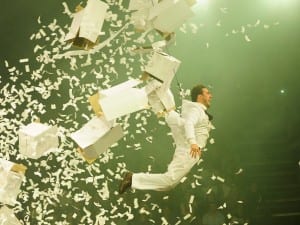As New Yorkers know from experience, artists are the shock troops of gentrification. As a Londoner this is taken more like an axiom than a principle but still seems to hold true. This can seem like an odd afterlife to the avant-garde dream of art rejuvenating a place to make it personal, aesthetic, humane, which makes Neo-Bankside both an exciting and risqué choice for a venue: a hi-rise development of £1.25–6 million flats offering views over Tate Modern and St. Pauls, with an empty bottom floor just big enough for Restate to occupy before they cover the concrete pillars, pipes and roof insulation with something more polished. The exhibition, which ran throughout April, featured five emerging artists who looked at how art can transform or chronicle somewhere, and how humans interact with that somewhere.
Stian Adlandsvik and Alona Rodeh both focused on what our things do without us, and both show them falling apart. Adlandsvik’s Self-Consuming Bastard (2012), a paper shredder that seems to have shredded itself, and Rodeh’s video Barking Dogs Don’t Bite (2012), where a pedestrian strolls oblivious outside as an empty gallery fills with smoke, triggering the sprinkler system, had the attractiveness of the koan about a tree falling in the forest and no one hearing it. Places do seem to exist without us; even if no one is around to see them falling trees make both a sound and a mess until, as at the end of Barking Dogs Don’t Bite, someone sees it and sweeps up.
Harry Thaler and Teresa Braula Reis thought about ways of making a space human. Thaler is a designer, making beautiful and practical ways to make a space inhabitable: apple crates stack together constructively in Twist and Lock (2010); Hang it on the Wall (2008) re-moulds lightbulbs enabling them to be hung from a nail like a picture. Reis’ constructions, on the other hand, seem to want to make a home while not quite sure where or how to do so. Made of metal rods and cement, A House within Its Shadow (2013) and A House to Live in #2 were highly rationalised attempts at laying the framework for a house that has no hope of being liveable.
Photographer Alicja Dobrucka’s photographs of unregulated hi-rises against the backdrop of Mumbai’s traditional low-rise housing were the pick of the bunch. Her photos are reminiscent of Gursky’s: a high-ish angle taking broad, big sweeps at an urban landscape becoming full to the brim. As curator Carmen Stolfi writes, “such a heavy landscape distortion with no relation to the architecture of the city leads back to Augé’s theory of non-place in which modernity constructs places anew without incorporating any former identity and, in doing so, destroying the peculiarity of places.” Humans can ruin with ambition what humans made through necessity.
Which was the irony at work here. As in revolutionary Modernism’s architecture wing, art can make utopias of dissolute places but Neo-bankside, however, is far from dissolute, or even un-optimised. London is a place where a square foot of land is an investment, and the better the place the better the investment. Now, urban regeneration through art looks (and sometimes is) power-sanctioned, like Soviet Realism, council-funded murals, or depictions of saints in the Renaissance. Perhaps it always was this way, but after a raucous 20th century where ideas were allowed to roam free in the real world – sometimes with disastrous consequences – money once again wants its sobering interests noted. As in Dobrucka’s Mumbai, places are for turning a profit. In London, art makes these new places seem human.
Restate, by Art:i:curate, 4-17 April, NEO Bankside, Pavilion A, 50 Holland Street, London SE1 9FU.
Jack Castle
Credits
1. Life is on a new high, Alicja Dobrucka.





